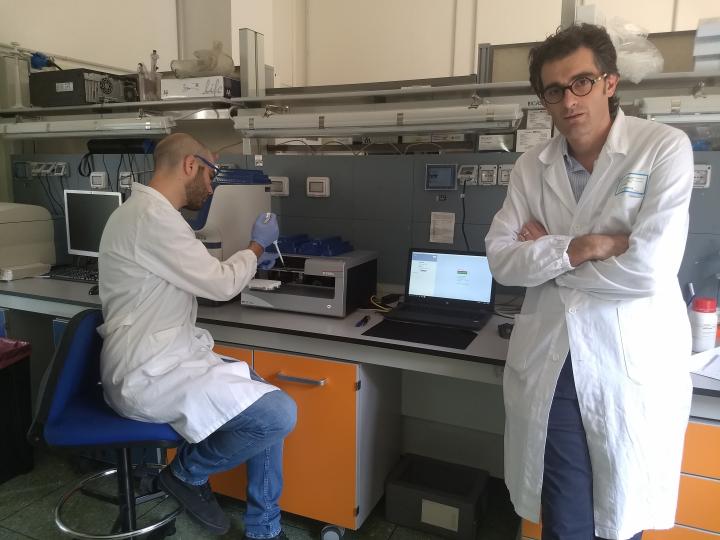Developing therapies to treat rare diseases is often hindered by the limited availability of primary patient samples. Without these precious samples, it is difficult to understand the fundamental biology of these conditions or screen compound libraries for drug candidates. A group at the University of Parma is using a ‘chemogenomics’ approach to overcome this challenge, working on a nanoliter scale to identify new treatments for aggressive pediatric leukemias.
Acute myeloid leukemia (AML) is an aggressive cancer affecting fewer than 10 in 100,000 people each year in Europe. The resulting scarcity of primary patient samples for in vitro testing presents a challenge for drug discovery laboratories seeking out novel compounds to treat them. A recently established group within the University of Parma’s Department of Medicine and Surgery aims to address this issue, using a wide range of sample types to investigate various aspects of leukemia and bone marrow transplantation. Physician Scientist Dr Giovanni Roti explained: “After spending several years at the Dana-Farber Cancer Institute in Boston, USA, I returned to Italy last year to set up a new unit for cancer research within the Hematology Unit here at the university. My work in Boston focused on pediatric cancers using chemogenomics – systematic screening of small molecule libraries against individual drug targets or target families – to identify new targets and drugs for aggressive diseases such as leukemia and neuroblastoma, and our work here is a natural progression of that.”
The Roti Lab takes a flexible approach to this research, adapting the techniques it uses according to the goal of the study and the samples available. Giovanni continued: “Sometimes we start with a tissue sample, sometimes we use cell lines or cancer models. But the basic process is always the same; start by investigating the cellular biology, then use this understanding to identify and validate therapeutic targets using both biochemical and genetic approaches, including CRISPR/Cas9 knockdown if required. We are currently working on two main projects; one for AML and the other for T-cell lymphoid leukemia (TLL). The AML project started as a chemogenomics screen for a modulator in primary AML, and we are now validating the result of this using the various models available to us in the lab. The second project stems from my previous work in Boston, which identified a modulator of a transcription factor which is frequently mutated in TLL. We are now collaborating with a biotech company to validate a small molecule drug that inhibits this target, with the goal of translating these findings for clinical use.”

Andrea Gherli (left) and Giovanni Roti are using the D300e to screen small molecule drugs for AML
On starting out, one of the lab’s first technology updates was to invest in a Tecan D300e Digital Dispenser, which it now uses in several different applications. “When we screen small molecules, we need to perform titrations to find their IC50 values in multiple cell lines or patient samples. Although this is possible to do manually in 96- well plates, it is very time consuming to pipette 12 or 14 different dilutions of up to 10 drugs for each cell type. The D300e simplifies this process considerably, as well as allowing us to work with smaller volumes in 384-well plates without the risk of pipetting errors. It is also really fast, taking between one and four minutes to set up an entire 384-well plate depending on the number of compounds you want to test. We can also perform synergy studies using this technology, which enables us to investigate many dilutions of two or more drugs in combination. This simply wouldn’t be possible manually, as the time required for pipetting would compromise the cells.”
"Essentially, we’re translating our pipeline from bench to bedside in a much shorter timeframe."
“The speed of the system also offers the exciting prospect of being able to work directly with patient samples to help inform therapies for the clinic. Our goal is to create a system for chemotherapy drugs similar to the antimicrobial sensitivity testing commonly used in clinical environments to guide antibiotic prescriptions. With the D300e, we don’t need a lot of time to set up the early phase of these experiments; we can go from receiving the patient samples to testing compounds in the incubator in just a couple of hours. If we happen to identify a molecule that is already in clinical trials or for another indication, we can ask permission from the local ethics committee to use the drug in patients. In a couple of cases, we’ve actually been able to see a repeat of what we’ve observed in vitro in these patients, so it’s proving to be a good prediction of in vivo responses. Essentially, we’re translating our pipeline from bench to bedside in a much shorter timeframe.”
“Another feature we really like about the Tecan D300e is that it is very user friendly, and only requires minimal training to set up even complex synergy studies. As a small laboratory, this is a fundamental consideration when investing in any new technology. With only two postdoctoral fellows and two PhD candidates – plus a rotation of students from master’s or undergraduate degrees – I cannot afford to have equipment that is not accessible any time and to everyone. The software automatically calculates how much of each compound is required – and can randomize plate layouts to avoid edge effects – which means that inexperienced users don’t have to perform a lot of calculations to work out the dilutions. Students with limited laboratory experience can therefore use this system without compromising the machine or risking errors, which is a huge advantage,” Giovanni concluded.
To find out more about Tecan’s drug discovery solutions, visit www.tecan.com/drugdiscovery
To learn more about the University of Parma’s Department of Medicine and Surgery, go to mc.unipr.it









